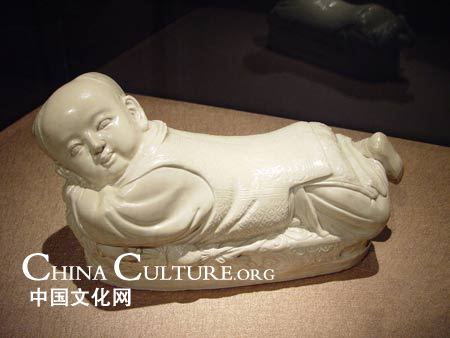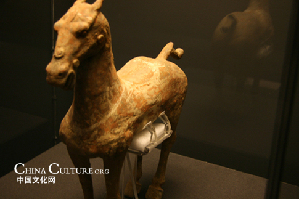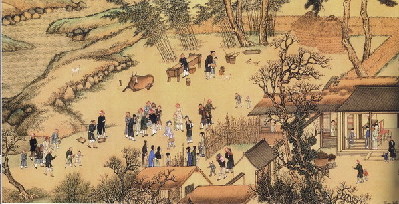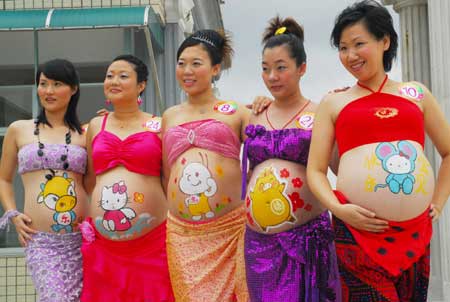| Home > Living in China > Art |
The Sui and Tang dynasties (581?60)
Main article: Tang Dynasty art
Buddhist architecture and sculpture

Following a transition under the Sui Dynasty, Buddhist sculpture of the Tang evolved towards a markedly lifelike expression. As a consequence of the Dynasty's openness to foreign influences, and renewed exchanges with Indian culture due to the numerous travels of Chinese Buddhist monks to India from the 4th to the 11th century, Tang dynasty Buddhist sculpture assumed a rather classical form, inspired by the Indian art of the Gupta period.
However, foreign influences came to be negatively perceived towards the end of the Tang dynasty. In the year 845, the Tang emperor Wu-Tsung outlawed all "foreign" religions (including Christian Nestorianism, Zoroastrianism and Buddhism) in order to support the indigenous Taoism. He confiscated Buddhist possessions and forced the faith to go underground, therefore affecting the ulterior development of the religion and its arts in China.
Most wooden Tang sculptures have not survived, though representations of the Tang international style can still be seen in Nara, Japan. The longevity of stone sculpture has proved much greater. Some of the finest examples can be seen at Longmen, near Luoyang, Yungang near Datong, and Bingling Temple, in Gansu.
Golden age of Chinese poetry
Yue fu are Chinese poems composed in a folk song style. The term literally means "music bureau", a reference to the government organization originally charged with collecting or writing the lyrics.
The lines are of uneven length, though five characters is the most common. Each poem follows one of a series of patterns defined by the song title. The term covers original folk songs, court imitations and versions by known poets.
From the 2nd century AD, the yue fu began to develop into shi—the form which was to dominate Chinese poetry until the modern era. The writers of these poems took the five-character line of the yue fu and used it to express more complex ideas. The shi poem was generally an expression of the poet's own persona rather than the adopted characters of the yue fu; many were romantic nature poems heavily influenced by Taoism.
The term gushi ("old poems") can refer either to the first, mostly anonymous shi poems, or more generally to the poems written in the same form by later poets. Gushi in this latter sense are defined essentially by what they are not; that is, they are not jintishi (regulated verse). The writer of gushi was under no formal constraints other than line length and rhyme (in every second line).
Jintishi, or regulated verse, developed from the 5th century onwards. By the Tang dynasty, a series of set tonal patterns had been developed, which were intended to ensure a balance between the four tones of classical Chinese in each couplet: the level tone, and the three deflected tones (rising, falling and entering). The Tang dynasty was the high point of the jintishi.
Notable poets from this era include Bai Juyi, Du Mu, Han Yu, Jia Dao, Li Qiao, Liu Zongyuan, Luo Binwang, Meng Haoran, Wang Wei, and Zhang Jiuling.
Li Po and Du Fu
Li Po and Du Fu both lived during the Tang Dynasty. They are regarded by many as the greatest of the Chinese poets.
Over a thousand poems are attributed to Li Po, but the authenticity of many of these is uncertain. He is best known for his yue fu poems, which are intense and often fantastic. He is often associated with Taoism: there is a strong element of this in his works, both in the sentiments they express and in their spontaneous tone. Nevertheless, his gufeng ("ancient airs") often adopt the perspective of the Confucian moralist, and many of his occasional verses are fairly conventional.
Much like Mozart, many legends exist on how Li Po effortlessly composed his poetry, even (or some say, especially) when drunk; his favorite form is the jueju (five- or seven-character quatrain), of which he composed some 160 pieces. Using striking, unconventional imagery, Li Po is able to create exquisite pieces to utilize fully the elements of the language. His use of language is not as erudite as Du Fu's but equally effective, impressing through an extravagance of imagination and a direct connection of a free-spirited persona with the reader. Li Po's interactions with nature, friendship, and his acute observations of life inform his best poems. Some of the rest, like Changgan xing (translated by Ezra Pound as A River Merchant's Wife: A Letter), records the hardships or emotions of common people. Like the best Chinese poets, Li Po often evades translation.
Since the Song dynasty, critics have called Du Fu the "poet historian". The most directly historical of his poems are those commenting on military tactics or the successes and failures of the government, or the poems of advice which he wrote to the emperor.
One of the Du Fu's earliest surviving works, The Song of the Wagons (c. 750), gives voice to the sufferings of a conscript soldier in the imperial army, even before the beginning of the rebellion; this poem brings out the tension between the need of acceptance and fulfillment of one's duties, and a clear-sighted consciousness of the suffering which this can involve.
Du Fu's work is notable above all for its range. He mastered all the forms of Chinese poetry: Chou says that in every form he "either made outstanding advances or contributed outstanding examples" (p. 56). Furthermore, his poems use a wide range of registers, from the direct and colloquial to the allusive and self-consciously literary. The tenor of his work changed as he developed his style and adapted to his surroundings ("chameleonlike" according to Watson): his earliest works are in a relatively derivative, courtly style, but he came into his own in the years of the rebellion. Owen comments on the "grim simplicity" of the Qinzhou poems, which mirrors the desert landscape (p. 425); the works from his Chengdu period are "light, often finely observed" (p. 427); while the poems from the late Kuizhou period have a "density and power of vision" (p. 433).
Late Tang poetry
Li Shangyin was a Chinese poet of the late Tang dynasty. He was a typical Late Tang poet: his works are sensuous, dense and allusive. The latter quality makes adequate translation extremely difficult. Many of his poems have political, romantic or philosophical implications, but it is often unclear which of these should be read into each work.
Li Yu was a Chinese poet and the last ruler of the Southern Tang Kingdom. His best-known poems were composed during the years after the Song formerly ended his reign in 975 and brought him back as a captive to the Song capital, Bianjing (now Kaifeng). Li's works from this period dwell on his regret for the lost kingdom and the pleasures it had brought him. He was finally poisoned by the Song emperor in 978.
Li Yu developed the ci by broadening its scope from love to history and philosophy, particularly in his later works. He also introduced the two-stanza form, and made great use of contrasts between longer lines of nine characters and shorter ones of three and five.
Painting

Beginning in the Tang dynasty (618?A class=ilnk onclick="assignParam('navinfo','method|4'+getLinkTextForCookie(this));" href="http://www.answers.com/topic/907" target=_top>907), the primary subject matter of painting was the landscape, known as shanshui (mountain water) painting. In these landscapes, usually monochromatic and sparse, the purpose was not to reproduce exactly the appearance of nature but rather to grasp an emotion or atmosphere so as to catch the "rhythm" of nature.
Painting in the traditional style involved essentially the same techniques as calligraphy and is done with a brush dipped in black or colored ink; oils were not used. As with calligraphy, the most popular materials on which paintings are made are paper and silk. The finished work is then mounted on scrolls, which can be hung or rolled up. Traditional painting also is done in albums and on walls, lacquerwork, and other media.
Dong Yuan was an active painter in the Southern Tang Kingdom. He was known for both figure and landscape paintings, and exemplified the elegant style which would become the standard for brush painting in China over the next 900 years. As with many artists in China, his profession was as an official where he studied the existing styles of Li Sixun and Wang Wei. However, he added to the number of techniques, including more sophisticated perspective, use of pointillism and crosshatching to build up vivid effect.
Zhan Ziqian was a painter during the Sui Dynasty. His only painting in existence is Strolling About In Spring arranged mountains perspectively. Because the first pure scenery paintings of Europe emerged after the 17th century, Strolling About In Spring may well be the first scenery painting of the world.
Art
 more
moreClassic Chinese Handicraft:
Porcelain pillows, as classic Chinese handicraft,

Chinese Treasures Returned from
As witness of Chinese culture and custom, countless treasures

The lost legacy: classical music
Accompany by the long history of China, Chinese classical music

Customs
 more
moreChinese Kungfu
Kungfu Taste: Learn Martial Art in Shaolin Temple
The mention of Shaolin Temple conjures up images of a quiet and
Keet Kune Do will reappears on screen: BRUCE Lee and
The Legend of Bruce Lee is shot by China Central Television
The Road to the Olympic Games for Wushu
Wushu, also called kungfu, martial arts, is attracting more and more




 print
print  email
email  Favorite
Favorite  Transtlate
Transtlate 
